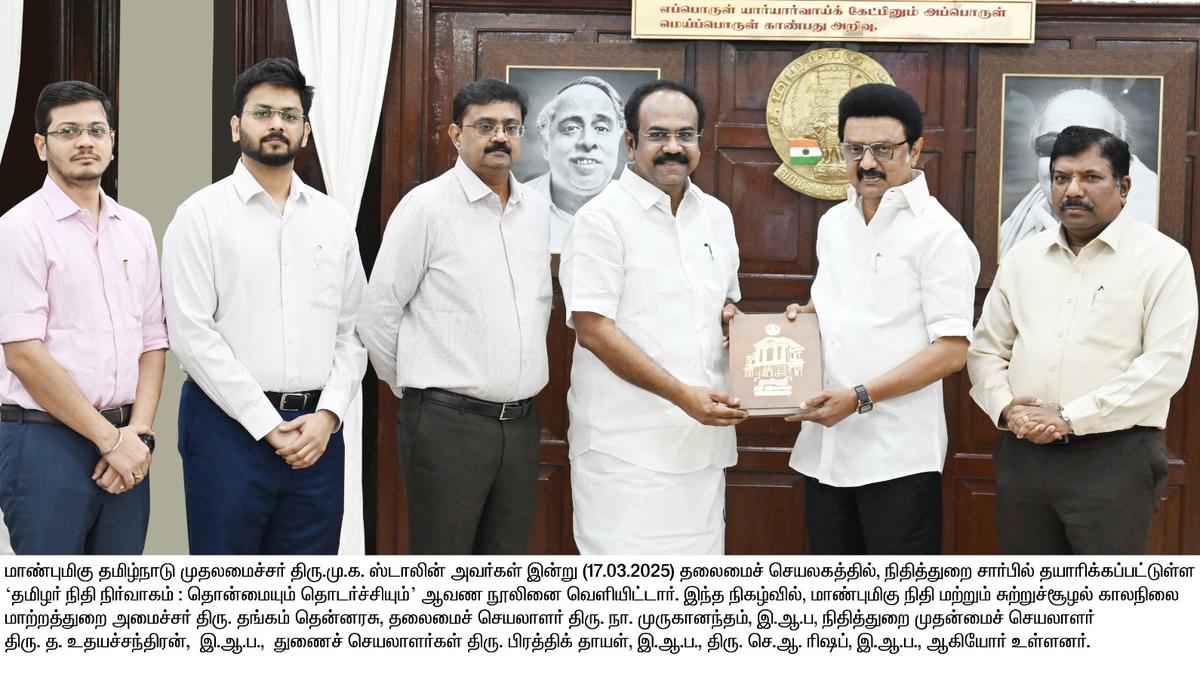
A publication that spotlights antiquity of fiscal administration in Tamil land
The Hindu
Explore the history of public finance in Tamil Nadu through Tamilar Nidhi Nirvakam, a richly detailed publication.
One hundred years ago, petrol was sold for ₹0.25 a litre in New Delhi when the British-owned Burmah Shell (precursor to Bharat Petroleum Corporation Limited) dominated the South Asian market. Then, the exchange rate of one U.S. dollar was ₹3.31. Ten grams of 24-carat gold was sold at ₹18.75. In January this year, the respective prices were ₹94.89, ₹86.61, and ₹81,170. The price of gold, valued by most Indians, had risen from ₹52,670 in 2022, when the Russia-Ukraine conflict broke out. The Tamil Nadu government’s revenue expenditure exceeded the ₹100-crore mark during 1961-62. Seven years later, revenue receipts touched the ₹200-crore mark. In 1980-81, both revenue receipts and revenue expenditure crossed the four-digit number — ₹1,000 crore — for the first time. (In the latest Budget (2025-26), the revenue expenditure has been estimated at ₹3,73,204 crore and revenue receipts ₹3,31,569 crore.)
All these details and much more form part of Tamilar Nidhi Nirvakam: Thonmaiyum Thodarchiyum (Tamils’ Fiscal Administration: Antiquity and Continuity), a publication brought out recently by the Finance Department of the Tamil Nadu government.
Public finance is tempting to those who have an appetite for the subject, though its impact is felt by every person. The subject acquires greater importance in a geographical zone that has been making a steady economic progress. And, when the territory in question has a long history in general and more so in public finance in particular, the subject should become all the more engrossing.
Through Tamilar Nidhi Nirvakam, the Finance Department has made an attempt, using aesthetic design, rare and old photographs, and colourful visual elements, to impress on any onlooker the significance of public finance, as understood and practised in the Tamil land over hundreds of years. The publication is a valuable collection of articles and speeches by experts in a host of disciplines such as history, archaeology, economics, Tamil studies, and water resources. It has been curated by Principal Secretary (Finance) T. Udhayachandran, whose passion for historical studies is well known.
The assessment of leading personalities in public life who left behind their lasting footprint — B.R. Ambedkar, C. Subramaniam, R. Venkataraman, and R.K. Shanmukham Chetty — has been captured in Tamilar Nidhi Nirvakam. Ambedkar’s analytical account of land revenue during the British East India Company’s reign, discussing the relative merits and demerits of the zamindari and ryotwari systems; Chetty’s lucid explanation of the need for governments to take loans; Subramaniam’s experience in the preparation of his maiden State Budget in 1953 (wherein he found, to his dismay, that most of the allocated funds were spent at the fag end of the financial year, a practice that has not yet been phased out); and Venkataraman’s insightful recollection of how the State underwent industrialisation in the formative years after Independence have added elegance to the publication.
Veteran historian K.A. Nilakanta Sastri’s illuminating piece on the Cholas’ emphasis on agriculture and irrigation, an equally educative one by seasoned academic P. Shanmugam on the state of economy from the Sangam Age to the periods of Pallavas and early Pandyas, applied economist B. Natarajan’s article on Thiruvalluvar and fiscal management, Tamil scholar Mylai Seeni Venkatasami’s account of how Tamils were adventurous and enterprising in pursuit of greener pastures in maritime trade and commerce, and Y. Subbarayalu’s piece on land revenue during the Cholas bring to the fore the amount of research and labour put in by members of the production team of the publication. A well-researched article by K.RShanmugam, former Director of the Madras School of Economics and the present adviser (economics) to the State government, on the evolution of State Budgets in the last 100 years, highlights the periods of stress and crisis that the State experienced in public finance. Another noteworthy piece is by M. Vijayabaskar, a political economist and Member of the Tamil Nadu State Planning Commission, on the State’s efforts to industrialise backward areas.
Tamilar Nidhi Nirvakam also captures the recent developments in a variety of fields, including information technology. It mentions that the 1958-59 Budget stressed the importance to be attached to technical education and research. There is an interesting photograph of seasoned academic and Tamil scholar V.C. Kulandaiswamy, who became Anna University’s Vice-Chancellor, explaining a computer product of IBM to Dravidar Kazhagam founder E.V. Ramasamy at the Guindy Engineering College in 1965, with the incumbent Dravidar Kazhagam leader, K. Veeramani, in the background. A few other photographs provide glimpses of “traffic-lean” Chennai of the 1960s and the 1970s. There is a table, giving a chronological account of the construction of dams and irrigation projects during the chief ministership of K. Kamaraj and M. Karunanidhi.





















 Run 3 Space | Play Space Running Game
Run 3 Space | Play Space Running Game Traffic Jam 3D | Online Racing Game
Traffic Jam 3D | Online Racing Game Duck Hunt | Play Old Classic Game
Duck Hunt | Play Old Classic Game











